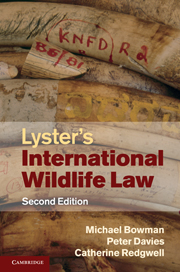Book contents
- Frontmatter
- Contents
- Foreword
- Preface
- List of abbreviations
- PART I Foundations of international wildlife law
- PART II Species regulation
- PART III Regional wildlife regulation
- PART IV Global wildlife regulation
- PART V Biological diversity: a new perspective on wildlife regulation
- PART VI Cross-sectoral issues in wildlife regulation
- PART VII Conclusion
- Index
Foreword
Published online by Cambridge University Press: 05 July 2011
- Frontmatter
- Contents
- Foreword
- Preface
- List of abbreviations
- PART I Foundations of international wildlife law
- PART II Species regulation
- PART III Regional wildlife regulation
- PART IV Global wildlife regulation
- PART V Biological diversity: a new perspective on wildlife regulation
- PART VI Cross-sectoral issues in wildlife regulation
- PART VII Conclusion
- Index
Summary
I am thrilled and delighted that a second edition of Lyster's International Wildlife Law has been written and published, and I feel very privileged to have been asked to write this foreword.
When I first wrote International Wildlife Law in the early 1980s, it was the most comprehensive book on the subject available – indeed pretty much the only one available! It reflected the growing concern at the time for threatened species and their habitats, and the emerging body of regional and global agreements to protect them. However, so much has changed since the early 1980s. Then the word ‘biodiversity’, to describe the variety of species and genetic material within species, had scarcely been invented, and there was no Biodiversity Convention. That was only signed in 1992, at the Earth Summit in Rio de Janeiro. Climate change was a subject that a few visionaries were starting to express concern about, but was nothing like the headline issue it is today.
And it is only in the last twenty-five years that the concept of sustainable development has taken centre stage. In the early days, wildlife conservation was seen as a sensible and moral thing to do to prevent species extinction. But the deep and strong interdependence between people and wildlife – the idea that meeting human development aspirations and wildlife conservation are dependent on each other, that you cannot save wildlife without taking account of human needs – was nothing like as widely accepted as it is today.
- Type
- Chapter
- Information
- Lyster's International Wildlife Law , pp. xiii - xivPublisher: Cambridge University PressPrint publication year: 2010



